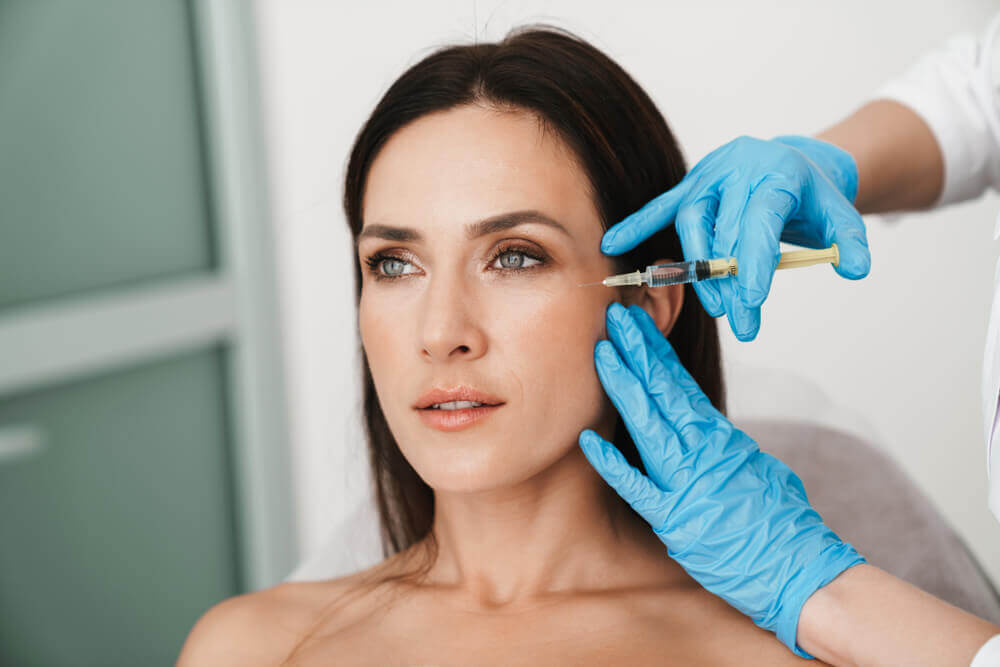Intro to Sculptra Training
National Laser Institute: Intro to Sculptra Training
You have taken the right steps toward advancing your career as a cosmetic injector by taking an intro to Sculptra training course. A cosmetic injector is a medical professional who is certified and trained to administer cosmetic injectables. These cosmetic injectables include dermal fillers, Botox, Sculptra, and more. As well as that, cosmetic injectors are responsible for assessing a patient’s needs to administer the proper treatments in order to achieve the patient’s desired result.
What is Sculptra?
 First, what is Sculptra? Sculptra belongs to a class of drugs called “Aesthetic Surgery Products.” Moreover, Sculptra is the name of a cosmetic injectable that is used to restore volume loss. With this in mind, once injected, the goal is to create a full, soft, and more contoured appearance. As well as that, Sculptra comes prepared as a freeze-dried preparation that comes in a glass vial sealed with a pentrable rubber stopper. Notably, the rubber stopper is covered by an aluminum seal and a plastic flip cap.
First, what is Sculptra? Sculptra belongs to a class of drugs called “Aesthetic Surgery Products.” Moreover, Sculptra is the name of a cosmetic injectable that is used to restore volume loss. With this in mind, once injected, the goal is to create a full, soft, and more contoured appearance. As well as that, Sculptra comes prepared as a freeze-dried preparation that comes in a glass vial sealed with a pentrable rubber stopper. Notably, the rubber stopper is covered by an aluminum seal and a plastic flip cap.
What is the chemical structure of Sculptra?
Important to note, Sculptra is a Poly-L-lactic (PLLA) acid. This is a synthetic form of lactic acid produced naturally within the body. In addition to the former, Sculptra is a biodegradable synthetic PLLA polymer, a string of lactic acid molecules, along with carboxymethylcellulose mannitol.
What makes up Sculptra?:
- Polylactic-L-lactic acid 150mg
- Sodium carboxymethylcellulose 90mg
- Non-Pyrogenic mannitol 127.50mg
How do you reconstitute Sculptra?
To reconstitute Sculptra, you use bacteriostatic water, which is sealed with a red top. Something important to remember is to not use bacteriostatic saline, which is reserved for Botox. In addition, do not use sterile water for irrigation. A few things to remember when reconstituting Sculptra are as follows:
1) Sculptra should be reconstituted with 5-8mL of bacteriostatic water.
2) Sculptra can be used immediately after reconstitution or stored at room temperature for up to 72 hours. With this in mind, research has shown that Sculptra is the safest and most effective to use within a 0-72 hour window.
3) Following the reconstitution of Sculptra with bacteriostatic water, you should shake the vial vigorously. This can be done by hand or by agitating the solution. Agitation of a solution means drawing up the solution with the needle and aggressively reintroducing it into the vial. The solution in the vial should be vigorously shaken for approximately one minute until the excipients have dissolved. Important to note, excipients are inactive substances that are added to a drug that assists in binding, preserving, or enhancing the effectiveness of the active ingredient. As well as that, excipients can be used to make a drug easier to swallow or be more palatable to the taste. A few common excipients include binders, lubricants, glidants, fillers, and flavoring agents.
4) Once the solution has been agitated, it should be checked for lumps. If there are lumps, the solution needs to be agitated more. For example, a finished solution appears as a white, translucent suspension, with a bit of foam formed at the top.
Addition of Lidocaine to Sculptra:
If desired, you can add Lidocaine to Sculptra to provide pain relief. To accomplish this, you add 1mL of 1% Lidocaine solution to the reconstituted Sculptra immediately before the procedure takes place. The recommended ratio of Lidocaine solution is always 1mL of 1%-2% Lidocaine solution, regardless of the reconstitution ratio. The most commonly recommended reconstitution of Sculptra today is 8mL of bacteriostatic saline solution, along with 1mL of 1% Lidocaine solution, to total out at 9mL of solution.
Intro to Sculptra Training: Dosing of Sculptra
The most common dosing of Sculptra for facial correction is two vials per treatment. However, treatments can range from a few vials to as many as ten vials for an area such as the derriere. Important to note, it is recommended that you do not exceed four vials of Sculptra for a single face treatment.
How much Sculptra is used for an average face treatment?: An average face treatment typically consists of two vials of Sculptra, which is injected bilaterally.
On average, how many treatments of Sculptra are needed to achieve patient outcomes?:
First, it is dependent on the severity of the facial volume deficits, as well as signs of aging. However, typically 1-4 treatments of Sculptra are needed to achieve a patient’s desired outcome. Important to note, you should discuss the process with your patient to formulate a treatment plan prior to the first treatment. With this in mind, a discussion prior is helpful in achieving the patient’s desired outcome.
Intro to Sculptra Training: The Aging Process
Aging is a biological process in which our body’s baseline cell proliferation diminishes. Due to this, there is a diminished level of bioresources. In fact, we lose approximately 1% of our collagen every year. A combination of myoatrophy, lipoatrophy, weakening of the fascia and bone reabsorption, as well as, reduced collagen, elastin, and fibrin levels work to create an advanced age appearance.
The visible signs of aging appear as follows:
- a shrinking of cheek volume
- a weakening of lip volume
- evidence of flat spots midface
- angular facial transitions
- deepening of the nasolabial folds
- sinking of the mentalis crease
- development of marionette lines
- jowls developing on the face
The signs of a youthful face are full, prominent cheeks, and smooth visible facial transitions. As well as that, a youthful face shows a firm jawline and a lack of lines around the lips.
Intro to Sculptra Training: Patient Assessment
Prior to the procedure, you should spend time doing an in-depth evaluation of the patient’s volume deficits and physical features. Once discussed, you should set expectations with your patient, as well as be sure to emphasize that the changes that will take place are not immediate. Instead, discuss that the changes will take place over the course of several weeks.
Considerations and Contraindications of Sculptra: What Should I Consider as a Cosmetic Injector?
- Multiple drug allergies
- Pregnancy or Breastfeeding
- Facial implants
- Any active skin infection or URI (Upper Respiratory Infection)
- Compromised immunity
- Allergy or sensitivity to any ingredients
- History of more than one anaphylactic reaction
Intro to Sculptra Training: Side Effects of Sculptra
Some possible serious side effects of Sculptra are hives, difficulty breathing, angioedema, and dizziness. In addition, other serious side effects include small lumps underneath the skin, swelling, fever, and sore throat.
Swelling and Sculptra
Important to note, make sure to let the patient know that post-procedure swelling is expected because of the fluid volume added during the procedure. For example, one, 2 vial treatment of Sculptra could involve injecting 18mL of fluid into the patient’s facial area.
Sculptra Nodules
One such problematic side effect of Sculptra is the delayed occurrence of subcutaneous papules and nodules. With this in mind, a papule is a raised area of skin tissue that’s less than one centimeter around. On the contrary, a nodule is a growth or lump of abnormal tissue.
Papules and nodules as a side effect of Sculptra are typically isolated to the injection site. These side effects can be minimized by avoiding injecting in too shallow of a plane on the face. Important to note, you should avoid the periorbital area.
Intro to Sculptra Training: Sculptra Injection Technique
Prior to the patient’s Sculptra procedure, markings should be made on the patient in order to outline the areas to be injected. Different techniques can be utilized to achieve the patient’s desired result. Certain techniques that can be utilized include linear threads, parallel threads, fanning, and cross-hatching. Fanning is the most common injection technique because it covers the area with the least amount of injection sites.
First, you should calculate the amount of product you have and subdivide it over the areas to be treated to make sure you will have the most optimal and even result. Important to note, do not overfill areas where there is a significant amount of deficit, as compared to hyaluronic acid fillers.
Some syringes that Sculptra can be drawn up with are 3mL, 5mL, or 10mL syringes. As well as that, Sculptra is injected using 26G or 25G strait needles because Sculptra has a large particle size. Due to this, the large particle size makes smaller needles likely to clog. With this in mind, thin-walled needles are recommended to reduce clogging of the lumen. However, if the needle becomes clogged during the procedure, you should remove the clogged needle and replace it with a new, sterile needle.
Where is Sculptra Injected? Sculptra is injected into the subcutaneous or supraperiosteal plane.
How Should You Inject Sculptra?
- First, to inject Sculptra, introduce the needle bevel up at a 30-40 degree angle until a desired, subdermal depth is reached.
- Once this point is reached, then, lower the angle and advance the needle. Important to note, a change in tissue resistance is felt once the needle crosses into the subcutaneous plane from the intradermal plane.
- Then, there will be a “smooth glide,” as the needle is advanced through the subcutaneous plane.
- Sculptra is injected using a tunneling/threading technique where a slow retrograde push is used to deposit the product in the subcutaneous plane. Make sure to always reflux/aspirate prior to injection to prevent complications, like vascular occlusion.
- If the injection is too shallow, the risk of superficial papules is increased. With this in mind, if the needle is visible in the dermis, then it is most likely too shallow and should be retracted and reinserted at the correct depth.
- When injecting, it is important to limit the amount of fluid per treatment to half of a vial. For example, if you are injecting a nasolabial fold with a vial that has a 9mL dilution, the maximum amount per side would be 4.5mL.
- Once injected, massage the treated areas in a circular motion intermittently as you are performing the procedure to ensure an even distribution of product When injecting, keep the syringe moving by shanking or swirling during the procedure to prevent both clogging and maintain a homogenous structure.









